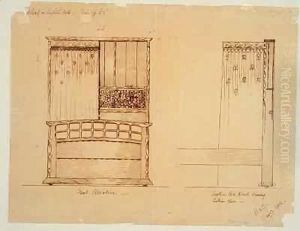Ernest & Gimson, Ernest W. Barnsley Paintings
Ernest Gimson and Ernest William Barnsley were two influential figures in the British Arts and Crafts Movement, which flourished at the end of the 19th and the beginning of the 20th centuries. Despite their shared first name and similar career paths, they were distinct individuals with their own contributions to the field of design and craftsmanship.
Ernest Gimson was born on December 21, 1864, in Leicester, England. He became one of the most influential designer-makers of his time. Initially trained in an architect's office in Leicester, Gimson's career took a significant turn when he moved to London and became associated with the designer and socialist William Morris, who was a leading figure in the Arts and Crafts Movement. Under Morris's influence, Gimson developed a strong belief in the importance of hand craftsmanship and the value of simple, functional design.
In the 1890s, Gimson relocated to the Cotswolds where he established workshops and continued to produce furniture, metalwork, plasterwork, and other items. His designs were characterized by their simplicity, solid construction, and the honest use of materials. Gimson's work was not just limited to design; he also played a key role in training a new generation of craftsmen, ensuring the continuation of traditional craft skills. He passed away on August 12, 1919, leaving behind a legacy that has continued to be celebrated and studied by aficionados of the Arts and Crafts Movement.
Ernest William Barnsley was born in 1863 in Birmingham, England. He was a contemporary and close collaborator of Ernest Gimson. Like Gimson, Barnsley was heavily influenced by the Arts and Crafts Movement and was passionate about the revival of traditional craftsmanship. Along with his brother, Sidney Barnsley, and Gimson, he moved to the Cotswolds to pursue a simpler way of life and to establish a community of craftspeople. They worked together in Sapperton, Gloucestershire, where they designed and created furniture and other objects with a focus on handcrafted quality and the use of local materials.
Barnsley's work encapsulated the ideals of the Arts and Crafts Movement, emphasizing the beauty of natural wood and the skill of the craftsman. He often worked with native British woods and was known for his meticulous attention to detail and his dedication to fine craftsmanship. Barnsley's designs were less well-known than those of his contemporaries, but they were highly regarded by those who appreciated the ethos of the Arts and Crafts Movement. He continued his work in the Cotswolds until his death on December 16, 1926.
While Ernest Gimson and Ernest W. Barnsley shared similar values and worked closely together, each made his own mark on the world of design and craftsmanship. Their work and philosophy have had a lasting impact on the appreciation of handcrafted goods and the history of British design.
